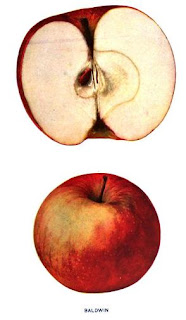The Baldwin is believed to have originated as a chance seedling on the farm of John Ball, near present-day Wilmington, Massachusetts sometime around 1740. The "discovery" of the apple however, is commonly credited to a man by the name of William Butters, who later come into possession of the farm and named the apple the Woodpecker or Pecker for short, in honor of the many Woodpeckers he observed frequenting the tree. Even after it's naming however, the apple largely remained unknown until a local surveyor by the name of Deacon Samuel Thompson, encountered the tree and brought the apples to the attention of Loammi Baldwin. Baldwin a Colonel and an engineer on the Middlesex Canal, took a liking to the apple and is largely responsible for it's propagation and further introduction into other parts of New England. A statue of the Colonel at North Woburn is wreathed in apples and reads "Disseminator of the apple in honor of him called the Baldwin apple, which proceeds from a tree growing wild about 2 miles north of this monument." The original tree is believed to have perished sometime between 1817 and 1832.
By the early 1800s the apple had began to spread to other parts of New England and in 1833 the New American Orchardist said about the Baldwin, "No apple in the vicinity of Boston is so popular as this, at the present day. It is raised in large quantities for the market...and is recommended for extensive cultivation" By mid-century the apple had spread well beyond eastern Massachusetts and in 1852 a man by the name of Hovey published a description of the Baldwin in which he stated:
The Baldwin is the most popular apple of New England, and is cultivated to a much greater extent than any other variety. Several large and fine orchards are to be found in the vicinity of Boston, some of which produce about one thousand barrels of fruit every bearing year. For exportation it is much sought after; and the large number of f1fteen hundred barrels have been sent to the East Indies in one season
The apple held prominence in New England and other parts of the Northeast, including New York, throughout the 19th century. However, by the early 1900s the Baldwin began to loose favor as an eating apple, being replaced by the Jonathan. It's plight was not helped by an especially cold winter in 1934 that wiped out entire Baldwin orchards in many parts of New England. After this massacre, many of the orchards were either never replanted or were replaced by new cultivars. Because of its desirability as a cider apple, however, it can still be found in many parts of the Northeastern United Sates.
 | |
| Baldwin at Cornell Orchards, early September |


We had one large Baldwin apple tree in our yard (late 1960-70s) and it kept us in nice storage apples all winter. Very tasty versatile apple.
ReplyDelete